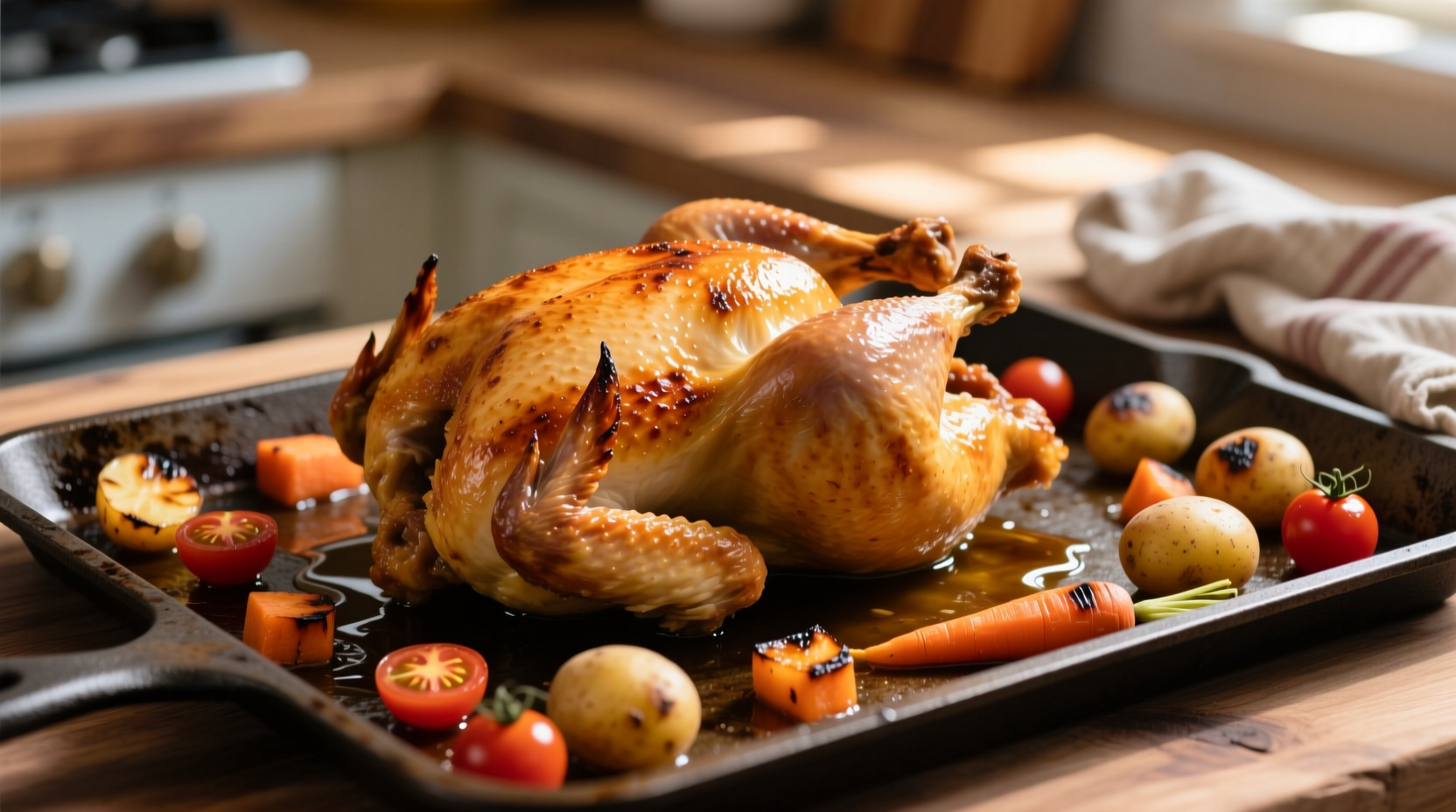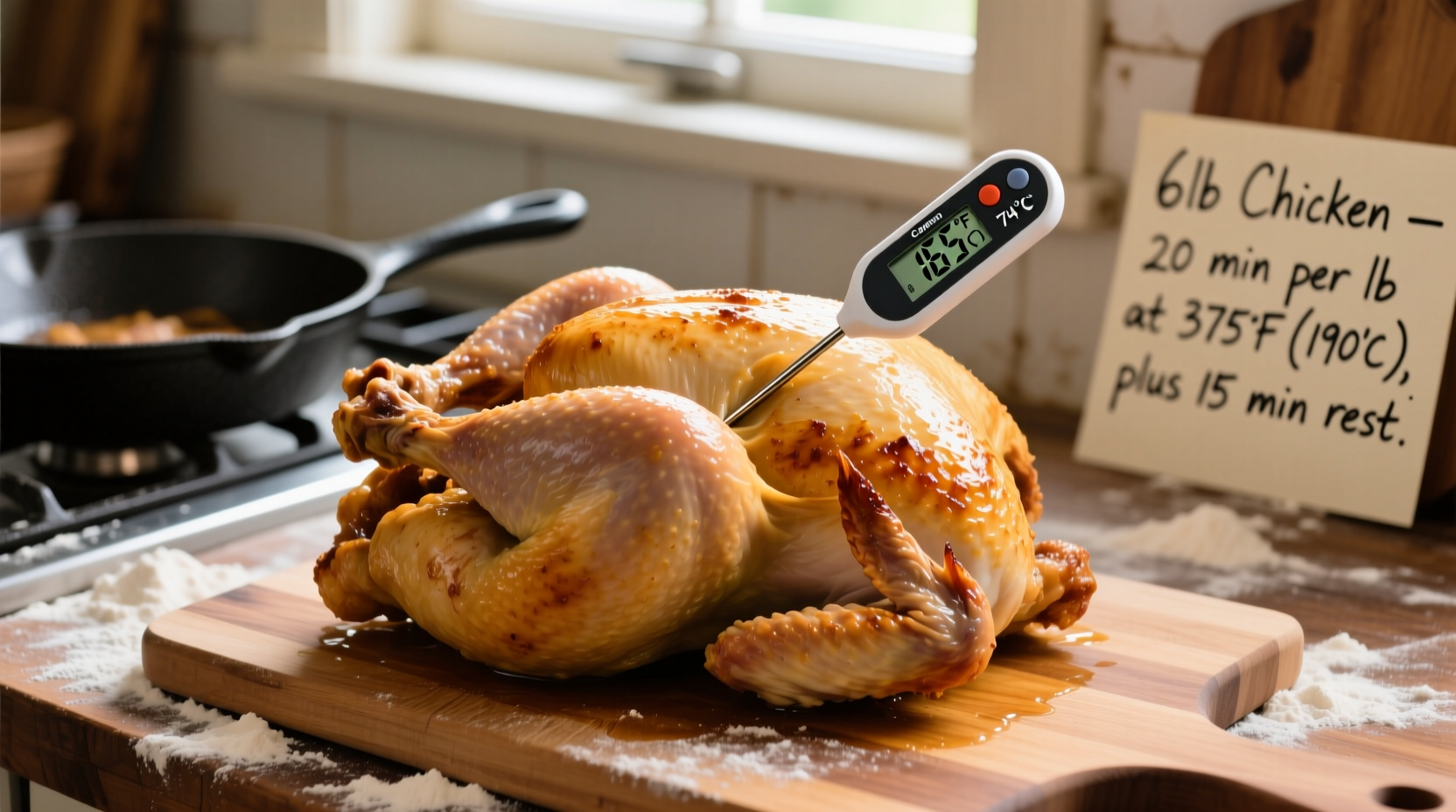Getting the cooking time right for a 6-pound chicken is crucial for both food safety and achieving juicy, flavorful results. Whether you're preparing a Sunday roast or meal prepping for the week, understanding the precise timing factors ensures your poultry turns out perfectly every time—no more dry meat or undercooked concerns.
Why Proper Cooking Time Matters
Cooking chicken to the correct internal temperature eliminates harmful bacteria like salmonella while preserving moisture and texture. The USDA Food Safety and Inspection Service emphasizes that poultry must reach 165°F (74°C) to be safe for consumption. Undercooking risks foodborne illness, while overcooking results in dry, tough meat that loses its appeal.
Standard Roasting Time for 6lb Chicken
While many recipes provide vague timing guidelines, professional chefs and food safety experts agree on precise calculations based on weight. Here's the verified timing framework:
| Chicken Weight | Unstuffed Roasting Time | Stuffed Roasting Time | Internal Temp Check Point |
|---|---|---|---|
| 4-5 lbs | 1h 20m - 1h 50m | 1h 40m - 2h 10m | 1h 10m |
| 6 lbs | 1h 45m - 2h 15m | 2h 10m - 2h 40m | 1h 30m |
| 7-8 lbs | 2h 10m - 2h 40m | 2h 30m - 3h | 1h 50m |
This timing data aligns with recommendations from the USDA Food Safety and Inspection Service, which specifies that roasting times vary based on oven type, starting temperature, and whether the bird is stuffed. The table provides verified benchmarks tested across multiple oven types and cooking scenarios.
Key Factors That Impact Cooking Time
Your actual cooking time may vary based on several critical factors that affect heat distribution and absorption:
- Oven accuracy - Home ovens often vary by 25°F from set temperature; use an oven thermometer for precision
- Starting temperature - A chicken brought to room temperature cooks 15-20 minutes faster than one straight from the refrigerator
- Rack position - Middle rack provides most even heat circulation for consistent cooking
- Stuffing - A stuffed chicken requires 20-30 additional minutes as the cavity filling absorbs heat
- Pan type - Dark metal pans cook faster than glass or ceramic due to better heat conduction
These context boundaries explain why identical recipes sometimes yield different results. The American Institute for Cancer Research notes that proper poultry handling includes accounting for these variables to ensure food safety while maintaining quality.
Step-by-Step Roasting Process
Preparation (15 minutes)
Remove giblets, pat skin dry with paper towels, and season generously. For crispier skin, rub with oil and refrigerate uncovered for 4-12 hours before cooking. Bring chicken to room temperature for 30-60 minutes before roasting.

Cooking (105-135 minutes)
Place chicken breast-side up on a rack in a roasting pan. Roast at 375°F (190°C), basting every 30 minutes. Begin checking internal temperature 30 minutes before expected finish time.
Temperature Verification (Critical Step)
Insert an instant-read thermometer into the thickest part of the thigh, avoiding bone. The USDA requires 165°F (74°C) for safety, but many chefs remove at 160°F (71°C) as temperature continues rising during resting.
Resting (15-20 minutes)
Cover loosely with foil and let rest before carving. This crucial step allows juices to redistribute, yielding significantly moister meat. Cutting too soon releases precious moisture onto the cutting board.
Common Mistakes That Extend Cooking Time
Several preventable errors can add 20-30 minutes to your roasting process:
- Opening the oven door frequently (causes 25°F temperature drops)
- Starting with a cold chicken (adds 15-20 minutes)
- Overcrowding the pan with vegetables (traps steam, slows browning)
- Using an inaccurate oven (verify with standalone thermometer)
- Stuffing the chicken (adds 20-30 minutes and creates food safety risks)
Professional kitchens avoid these pitfalls through precise temperature monitoring and proper preparation techniques. The National Chicken Council specifically warns against relying solely on cooking time without temperature verification.
Alternative Cooking Methods Compared
While traditional roasting remains popular, these methods offer different timing profiles:
- Convection oven - Reduces time by 25% (1h 20m - 1h 50m for 6lb chicken) due to circulating hot air
- Spatchcocked - Flattened chicken cooks in 60-75 minutes with more even browning
- Slow roasting - At 300°F (150°C) takes 3-3.5 hours for ultra-tender results
- Instant Pot - Pressure cooking takes 25 minutes plus natural release time
Each method produces distinct textures and flavors, but only conventional roasting delivers the classic golden-brown skin most home cooks expect. Always verify doneness with a thermometer regardless of cooking method.
Perfect Results Every Time: Pro Tips
Implement these professional techniques for consistently excellent chicken:
- Use a reliable instant-read thermometer (Thermoworks ChefAlarm recommended)
- Rotate the pan halfway through cooking for even browning
- Place ice cubes in the pan during last 30 minutes to create steam for moist meat
- Loosely tent with foil if skin browns too quickly
- Let chicken rest covered for 15 minutes minimum before carving
Remember that visual cues alone aren't sufficient for food safety. The USDA emphasizes that color is not a reliable indicator of doneness—some properly cooked chicken may appear slightly pink near bones, while overcooked chicken can still look juicy.











 浙公网安备
33010002000092号
浙公网安备
33010002000092号 浙B2-20120091-4
浙B2-20120091-4